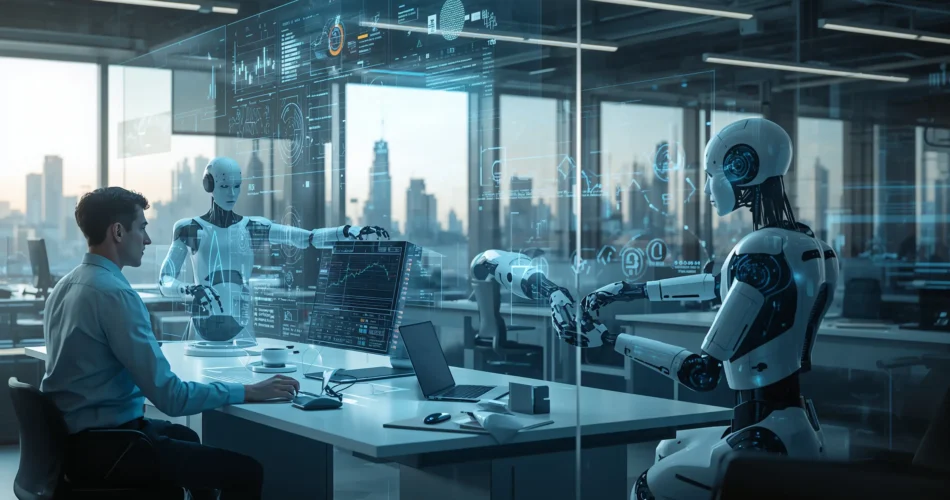Introduction: The Age of AI, Robotics, and Automation
AI and robotics are no longer distant possibilities. They are already changing how we work, live, and solve problems. From automated assembly lines in smart factories to intelligent systems diagnosing diseases, these technologies are influencing almost every major industry.
This shift is part of what many call Industry 4.0. It’s a phase where human-robot collaboration, workplace automation, and advanced data analysis are driving efficiency and creativity in ways we’ve never seen before. Companies are using AI to make faster decisions, cut operational costs, and handle tasks that once demanded significant human effort.
For individuals, this is both exciting and challenging. There is an opportunity to work alongside powerful technologies and a clear need to develop new skills to remain valuable in a rapidly evolving job market. The pace of change is fast, and those who adapt will shape the next chapter of innovation.
The Future of Work with Robots, AI, and Automation
From Task Replacement to Collaboration
The future of work with robots, AI, and automation isn’t just about replacing human jobs. Intelligent machines are now collaborating with people in decision-making, problem-solving, and innovation. This hybrid workforce allows humans and machines to work together, combining human creativity with AI precision.
Skills for the AI-Driven Workplace
As automation handles repetitive tasks, workers need to focus on roles that require creativity, strategic thinking, and emotional intelligence. Reskilling and upskilling programs are critical, helping people adapt to new roles that demand digital fluency, adaptability, and critical thinking.
Balancing Technology and Human Values
AI-powered decision-making is transforming leadership. While data and analytics can guide strategic choices, human judgment remains essential for interpreting context and making ethical decisions. The challenge lies in balancing technological efficiency with the human values that shape meaningful work.
AI and Robotics in Key Industries
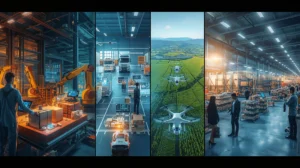
Manufacturing: The Rise of Smart Factories
In manufacturing, smart factories are combining robotics, AI, and IoT to create highly efficient production environments. Collaborative robots (cobots) work alongside human teams, handling repetitive or hazardous tasks while people manage quality control and problem-solving. AI-powered predictive maintenance helps avoid costly downtime by detecting equipment issues before they cause breakdowns.
Logistics and Supply Chain Automation
AI and robotics are reshaping global logistics. Automated warehouses, AI-driven route optimization, and autonomous delivery systems are reducing costs and speeding up operations. Machine learning algorithms analyze real-time data to improve delivery times, forecast demand, and streamline inventory management.
Agriculture: Precision Farming at Scale
Agriculture is adopting AI-powered machinery and robotics to improve crop yields and reduce waste. Robots equipped with computer vision can identify weeds, pests, and water deficiencies, allowing farmers to act quickly. Drones survey large fields in minutes, providing accurate data for planting and harvesting decisions.
Retail: Smarter Customer Experiences
In retail, AI and robotics are improving both customer service and operations. Automated checkout systems, inventory-tracking robots, and personalized shopping recommendations are becoming common. AI helps retailers predict buying trends, optimize stock levels, and offer tailored promotions based on customer behavior.
The integration of AI and robotics in industrial development is not just about efficiency — it’s about creating adaptive systems that can respond to changing market demands, drive innovation, and maintain high quality across industries.
AI and Robotics in Healthcare
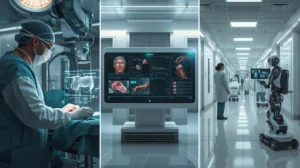
Surgical Assistance and Precision Procedures
AI and robotics in healthcare are transforming the way surgeries are performed. Surgical robots provide unmatched precision, allowing doctors to operate through smaller incisions, reduce recovery times, and minimize risks. These systems are guided by AI algorithms that assist surgeons in making real-time decisions during complex procedures.
Smarter Diagnostics and Treatment Plans
AI diagnostic tools are revolutionizing patient care by detecting diseases earlier and with higher accuracy. From analyzing medical imaging to identifying rare conditions, AI systems process vast amounts of data in seconds. Combined with robotics, these technologies enable faster and more personalized treatment plans, improving patient outcomes.
Remote Care and Telemedicine
Robotics and AI are making healthcare more accessible through telemedicine and remote patient monitoring. Robotic systems can perform check-ups, assist in rehabilitation, and monitor patients from a distance, which is especially valuable in rural or underserved areas. AI-driven platforms allow doctors to assess patients virtually while maintaining the quality of in-person care.
Hospital Operations and Efficiency
Inside hospitals, AI and robotics are streamlining operations. From automated medication dispensing to AI-powered scheduling systems, these tools help staff work more efficiently. Service robots assist with tasks such as delivering supplies and disinfecting rooms, freeing up medical staff to focus on patient care.
The role of AI and robotics in healthcare continues to expand. These technologies not only enhance medical capabilities but also improve access, efficiency, and overall quality of care for patients around the world.
Education and Careers in AI & Robotics
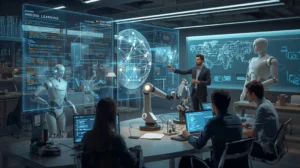
Academic Pathways and Degree Programs
The demand for skilled professionals in AI and robotics has created a growing number of specialized academic programs. Universities around the world now offer undergraduate and postgraduate degrees such as a robotics engineering degree or a master’s in AI and robotics. These programs combine theoretical knowledge with hands-on experience, preparing students for careers in industries that are rapidly adopting automation.
AI and Robotics Courses and Syllabus
AI and robotics courses cover a broad range of subjects, from programming and machine learning to computer vision and autonomous systems. A typical AI and robotics syllabus might include modules on deep learning applications, control systems, sensor integration, and ethical considerations in AI. Some programs also focus on niche areas like reinforcement learning or human-robot interaction, equipping students with skills that are in high demand.
Choosing the Best Programming Languages
Programming is at the core of AI and robotics. The best programming language for robotics and AI often depends on the application, but Python, C++, and Java are among the most popular choices. Python is widely used for AI development due to its extensive libraries for machine learning, while C++ is preferred for robotics because of its speed and efficiency. Learning multiple languages can give aspiring engineers an edge in a competitive job market.
Career Opportunities and Industry Demand
Graduates with expertise in AI and robotics are finding opportunities in sectors such as manufacturing, healthcare, defense, logistics, and research. Roles range from robotics engineers and AI developers to data scientists and automation specialists. With industries continuing to embrace these technologies, career prospects are expected to remain strong for years to come.
Education in AI and robotics is not just about earning a degree. It’s about developing the skills and mindset to innovate, solve complex problems, and work alongside intelligent machines in shaping the future.
Research and Technological Advancements
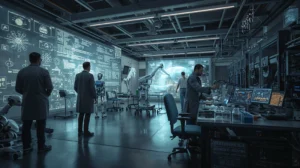
Pioneering Research in AI and Robotics
Research in AI and robotics is expanding at a remarkable pace. Academic institutions, private companies, and government agencies are producing groundbreaking AI and robotics research papers that push the boundaries of what machines can do. These studies cover everything from advanced algorithms and learning models to new hardware designs, creating a solid foundation for future innovation.
Computer Vision and Intelligent Perception
Computer vision and robotics in AI form one of the most critical areas of development. By enabling machines to process and interpret visual data, researchers are giving robots the ability to navigate environments, recognize objects, and interact with humans more effectively. From autonomous vehicles to inspection drones, computer vision is essential for making machines smarter and more adaptive.
The Role of Parallel Processing
Parallel processing in AI and robotics allows complex tasks to be completed much faster by dividing them into smaller processes that run simultaneously. This approach is vital for real-time decision-making in robotics, where speed and accuracy are crucial. Whether it’s processing sensor data, running machine learning models, or simulating environments, parallel computing ensures that robots can respond quickly and efficiently.
Emerging Technologies Shaping the Future
Beyond current capabilities, emerging technologies like edge AI, reinforcement learning, and neural networks in robotics are setting the stage for more autonomous and intelligent systems. These advancements will allow robots to learn on the go, make decisions without cloud dependency, and operate in dynamic, unpredictable environments.
Continuous research and technological progress are the driving forces behind the rapid evolution of AI and robotics. As these innovations mature, they will redefine industries, enhance human capabilities, and open new possibilities we are only beginning to imagine.
Legal, Ethical, and Social Impacts
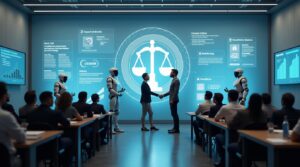
Navigating the Legal Landscape
As AI and robotics become more integrated into daily life, laws and regulations are struggling to keep pace. Robotics, AI, and the future of law is now a major area of discussion among policymakers worldwide. Issues like liability for autonomous systems, intellectual property rights for AI-generated work, and cross-border regulations for AI-powered technologies are still evolving. Governments must find ways to protect public safety while encouraging innovation.
Ethical Challenges of Intelligent Machines
The rise of autonomous weapons, often referred to as killer robots, has raised serious ethical concerns. Questions about accountability, decision-making in life-or-death situations, and the potential misuse of such technologies are being debated globally. Beyond weapons, AI ethics also extends to areas like bias in AI systems, data privacy, and the risk of reinforcing social inequalities through automated decision-making.
The Threat of Mass Unemployment
While AI and robotics can create new jobs, they also have the potential to replace millions of existing ones. The idea that AI and robots may cause mass unemployment is a real concern for economists and workers alike. Sectors like manufacturing, transport, and customer service are particularly vulnerable to automation. This shift requires governments and businesses to invest in reskilling initiatives, social safety nets, and policies that ensure a fair transition for displaced workers.
Building a Balanced Future
Addressing legal, ethical, and social challenges requires collaboration between technology developers, governments, businesses, and civil society. By creating transparent regulations, promoting ethical AI design, and supporting workforce transition, societies can ensure that AI and robotics are used responsibly for the benefit of all.
Economic Impact and Job Market Trends
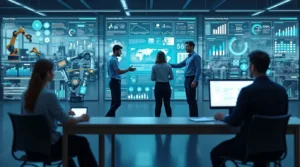
Transforming Employment Landscapes
AI and robotics in employment are reshaping the global job market. Intelligent systems are now capable of handling complex tasks, from financial analysis to customer service, at a scale and speed unmatched by humans. This shift is changing the nature of work, with more roles focusing on oversight, creativity, and problem-solving rather than manual or repetitive labor.
The Scale of Job Displacement
Reports predict that up to 300 million jobs will be replaced by AI and robotics in the coming years. Roles in manufacturing, logistics, and administrative support face the highest risk, while new opportunities emerge in AI development, maintenance, and integration. The challenge is ensuring that workers can transition into these new roles without being left behind.
Economic Growth and New Opportunities
Despite concerns, AI and robotics also have the potential to boost economies. Automation can increase productivity, reduce operational costs, and open new markets. Global robotics investments are growing, with industries such as healthcare, construction, and agriculture benefiting from increased efficiency and innovation.
Preparing for a Post-Automation Economy
Adapting to a post-automation economy requires strategic planning. Governments must invest in education and training programs that equip people with skills suited to an AI-driven world. Businesses should focus on integrating technology in ways that enhance human potential rather than replace it entirely. By doing so, societies can leverage the economic benefits of AI and robotics while minimizing social disruption.
The Global Landscape of AI and Robotics Companies
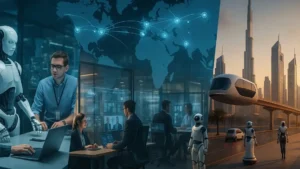
Leading Innovators Worldwide
Robotics and AI companies are at the forefront of technological transformation. From Silicon Valley to Tokyo, firms are developing intelligent machines and systems that push the limits of what technology can achieve. These companies range from established tech giants to agile startups, each contributing to advancements in automation, machine learning, and robotics engineering.
Regional Growth and Emerging Markets
While the United States, Japan, and Germany remain leaders in AI and robotics development, emerging AI markets are gaining traction. Countries in Asia, Europe, and the Middle East are investing heavily in research centers, incubators, and pilot projects. This growth is creating a more competitive and diverse global landscape.
AI and Robotics in Dubai and the Middle East
AI and robotics companies in Dubai are part of a broader regional push toward technology-led economies. Dubai’s smart city initiatives, government-backed AI strategies, and investment-friendly policies have attracted global and local firms. These companies are focusing on sectors such as logistics, healthcare, and infrastructure, using AI-driven solutions to enhance efficiency and innovation.
Collaboration and Future Outlook
Global AI and robotics companies are increasingly collaborating across borders. Joint ventures, research partnerships, and open-source platforms are accelerating the pace of innovation. As industries worldwide adopt these technologies, companies that can adapt to changing market needs and ethical considerations will be the ones shaping the next generation of AI and robotics solutions.
The Road Ahead – Preparing for an AI-Driven Future
Understanding the Shift in Job Roles
AI, robotics, and the future of jobs are closely linked. As automation continues to advance, traditional job roles will evolve or disappear. At the same time, entirely new professions will emerge in fields like AI development, robotics maintenance, data analysis, and human-machine interaction. Understanding this shift is the first step toward preparing for it.
Building Human-AI Synergy
Rather than viewing AI as a replacement for human labor, the focus should be on creating human-AI synergy. This approach combines the efficiency and speed of machines with human creativity, empathy, and ethical reasoning. Businesses that successfully blend these strengths will be more adaptable and competitive in a rapidly changing market.
Reskilling and Lifelong Learning
Reskilling programs will play a vital role in helping workers transition into future-ready careers. Lifelong learning, supported by both public and private initiatives, will ensure that employees stay relevant in a world where disruptive technologies are constantly emerging. Skills such as problem-solving, critical thinking, and digital literacy will become essential.
Policies and Collaboration for a Sustainable Future
Preparing for an AI-driven future will require coordinated efforts between governments, businesses, and educational institutions. Policies that encourage innovation while protecting workers’ rights are crucial. International collaboration can also help create shared ethical standards and promote the responsible use of AI and robotics worldwide.
The future belongs to those who can adapt, learn, and work alongside intelligent machines. By embracing change with the right mindset and skills, individuals and organizations can thrive in the era of AI and robotics.
Conclusion
The future of AI and robots is not a distant possibility. It is already taking shape in factories, hospitals, offices, and even our homes. These technologies are redefining the way we work, produce, and interact with the world around us. While challenges such as job displacement, ethical dilemmas, and regulatory gaps remain, the opportunities are equally powerful.
If adopted wisely, AI and robotics can improve productivity, create safer work environments, and open entirely new industries. The key lies in balancing technological progress with human values, ensuring that innovation serves society rather than disrupts it without preparation.
For individuals, the path forward is clear: stay adaptable, keep learning, and focus on skills that machines cannot replicate. For businesses and governments, the priority is to invest in education, ethical frameworks, and inclusive policies that enable everyone to benefit from the transformation.
We are standing at a pivotal moment in history. The choices made today will determine whether the future of AI and robots becomes a story of shared prosperity or one of missed opportunities.

